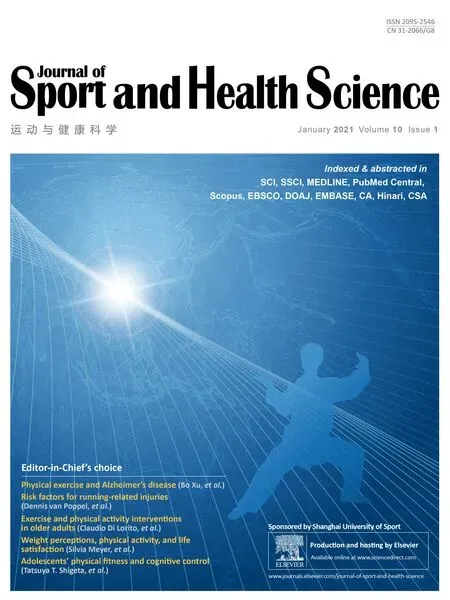Response to:Caution needed when interpreting muscle activity patterns during extremely low pedaling cadenceT
Sangsoo Park*,Graham E.CaldwellT
Department of Kinesiology,University of Massachusetts Amherst,Amherst,MA 01003,USA T
Received 12 May 2020;revised 25 May 2020;accepted 27 May 2020 Available online 4 June 2020
2095-2546/©2021 Published by Elsevier B.V.on behalf of Shanghai University of Sport.This is an open access article under the CC BY-NC-ND license.(http://creativecommons.org/licenses/by-nc-nd/4.0/)
Dear editor,
We would like to thank Drs Sun and Li for their interests and observations for our recently published article entitled“Muscular activity patterns in 1-leggedvs.2-legged pedaling”.We have carefully read their letter and agree with their underlying premise that our low cadence is not indicative of competitive,recreational,or(in some cases)clinical 2-legged pedaling cadence.However,our results were not meant to be extrapolated to higher cadences,as clearly stated in the Limitations Section of the Discussion:“The results of this study do not necessarily extend to muscular control in one-legged pedaling tasks with different mechanical demands,as our participants were asked to perform pedaling tasks with relatively low crank torque and velocity.”1Further,we stand by the initial statement of the Abstract that“One-legged pedaling is of interest to elite cyclists and clinicians.”In the Introduction we cite 2 studies2,3that refer to 1-legged cycling:“As such,1-legged pedaling has been suggested as a training tool to improve pedaling performance and is used in clinical settings for rehabilitation.”1Our opening Abstract statement(which would presumably be read before the Results and Discussion)was not meant to imply that our study results would be directly applicable to elite cyclists and all clinical populations/treatments,as Drs Sun and Li seem to infer.
It is well-established in the cycling literature that muscle activities change with cadence and power.4-7Muscular activity patterns found at the low 30 revolutions per minute(rpm)pedaling rate could still be informative to clinicians.A previous study examined muscle coordination strategy in 2-legged pedaling from 20 rpm to 50 rpm in 10 rpm increments,and reported 30 rpm as the easiest pedaling rate for their stroke survivors,8suggesting preferred pedaling rate in stroke survivors would be lower than in a healthy population.6The slower preferred pedaling rate might originate from impaired motor function in the affected side;thus,our results may be valuable to either understand or evaluate impaired muscular control in the stroke-affected side in 2-legged and 1-legged pedaling tasks.
Despite the low 30 rpm cadence in our study,muscular activity patterns are not inconsistent with previous findings.For example,Drs Sun and Li mention that the timing for peak rectus femoris(RF)activity in 2-legged pedaling reported in our study has not been observed in previous cycling studies.6,9However,peak RF timing was just before top dead center(0˚)at 50 rpm in Marsh and Martin’s6article and at 60 rpm in Baum and Li’s9article,consistent with our results.For biceps femoris long head(BFL),the peak value was observed near 150˚at 60 rpm in Baum and Li’s9article,and the BFL activity onset10and peak value6,9occurred later in the crank cycle as pedaling rate decreases,suggesting the later onset BFL peak timing in our study at 30 rpm is not unrealistic.Our 1-legged muscle activity patterns are also consistent with previous studies.11,12
We thank Drs Sun and Li for their interest in our study again.We certainly agree with their contention that cadence changes muscle activity patterns,which is why the study limitation related with the low pedaling rate was clearly stated in the Discussion Section of our article.
Authors’contribution
SP and GEC contributed to the writing of the letter.Both authors have read and approved the final version of the manuscript,and agree with the order of presentation of the authors.
Competing interests
Both authors declare that they have no competing interests.
 Journal of Sport and Health Science2021年1期
Journal of Sport and Health Science2021年1期
- Journal of Sport and Health Science的其它文章
- Caution needed when interpreting muscle activity patterns during extremely low pedaling cadenceT
- Author biographies of Editor-in-Chief’s choice
- Association between physical activity and digestive-system cancer:An updated systematic review and meta-analysisT
- Risk factors for overuse injuries in short-and long-distance running:A systematic reviewT
- Physical exercise may exert its therapeutic in fluence on Alzheimer’s disease through the reversal of mitochondrial dysfunction via SIRT1-FOXO1/3-PINK1-Parkin-mediated mitophagyT
- Exercise interventions for older adults:A systematic review of meta-analysesT
